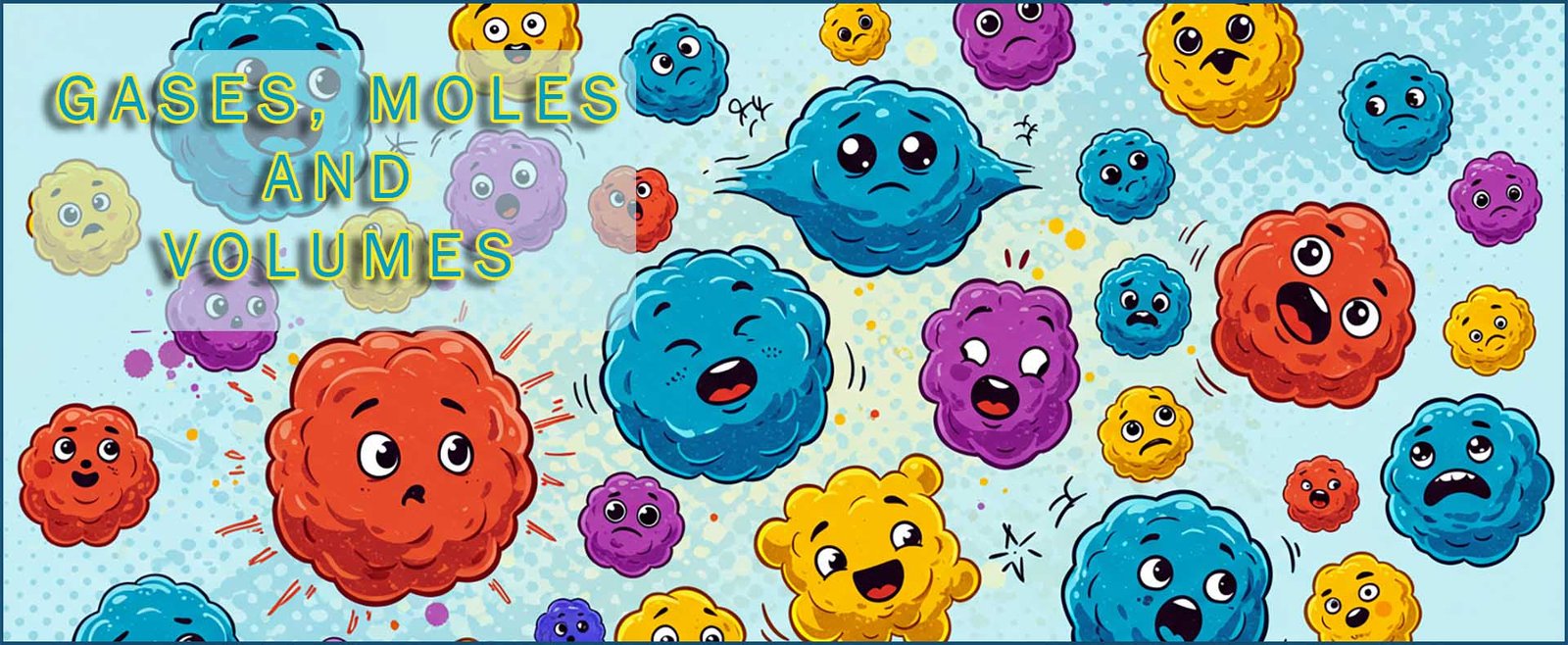

Chemistry only- higher tier
The table below gives the formula and the mass of 1 mole for a number of different gases.
| gas | molecular formula | Ar | mass of 1 mole/g |
|---|---|---|---|
| hydrogen | H2 | 2 | 2 |
| helium | He | 4 | 4 |
| oxygen | O2 | 32 | 32 |
| methane | CH4 | 16 | 16 |
| carbon dioxide | CO2 | 44 | 44 |
| butane | C4H10 | 58 | 58 |
 Remember gases are mostly empty space with
large gaps between the particles. The volume that
a gas occupies depends on its temperature
and pressure. If you heat a gas up it will expand
and take up more space and if you cool it down then its volume will decrease.
Squashing a gas or
putting it under pressure will also decrease its
volume while reducing the pressure on a gas
will cause it to expand. So when you talk about the volume a
gas occupies you should really state
the temperature and pressure as well.
Remember gases are mostly empty space with
large gaps between the particles. The volume that
a gas occupies depends on its temperature
and pressure. If you heat a gas up it will expand
and take up more space and if you cool it down then its volume will decrease.
Squashing a gas or
putting it under pressure will also decrease its
volume while reducing the pressure on a gas
will cause it to expand. So when you talk about the volume a
gas occupies you should really state
the temperature and pressure as well.
Avogadro's theorem (also called Avogadro's law) states that:
Equal volumes of gases, at the same temperature and pressure, contain the same number of particles (molecules).
This principle explains why 1 mole of any gas occupies the same volume at room temperature and pressure (RTP), typically 24 dm3 (24 litres).
The table below is almost identical to the one above with the exception of the last column which shows the molar volume, that is the volume occupied by 1 mole of that particular gas. As you can see 1 mole of any gas occupies 24 litres or 24 dm3 at 200C and 1 atmosphere pressure.
| gas | molecular formula | Ar | mass of 1 mole/g | volume gas will occupy at RTP/dm3 |
|---|---|---|---|---|
| hydrogen | H2 | 2 | 2 | 24 |
| helium | He | 4 | 4 | 24 |
| oxygen | O2 | 32 | 32 | 24 |
| methane | CH4 | 16 | 16 | 24 |
| carbon dioxide | CO2 | 44 | 44 | 24 |
| butane | C4H10 | 58 | 58 | 24 |
Calcium carbonate (CaCO3) decomposes when heated according to the equation below:
So the number of moles calcium carbonate present = 50g/100 = 0.5 moles.
Now from the balanced symbolic equation above we already know that:
1 mole of CaCO3will produce 1 mole of carbon dioxide (44g) gas.
So 0.5 moles of CaCO3 will produce 0.5 moles of carbon dioxide (22g) gas.
So 0.5 moles of CO2 gas will occupy 24dm3 x 0.5 = 12dm3
The formula to use to calculate the volume of a gas
relies on knowing how many moles of gas you have,
you simply multiply the number of moles by the molar volume,
that is 24dm3. This of course assumes that the temperature and
pressure are at room temperature and pressure.

The Haber process is used to make ammonia gas (NH3), this is shown in the equation below:
This balanced symbolic equation shows that 1 mole of nitrogen gas reacts with 3 moles of hydrogen gas to produce
2 moles of ammonia gas.
What volume of
ammonia gas will be produced if 500cm3 of nitrogen gas react with an excess of hydrogen gas at RTP?
This time instead of using reacting masses the question gives volumes of reactants. However we know that the
temperature
and pressure stay constant. We also know that:
Alternatively you can work out the number of moles of nitrogen gas present by simply dividing the reacting volume of the nitrogen gas; that is 500cm3 by 24 000 cm3, that is the reacting volume of nitrogen divided by the molar volume, which gives 0.02 moles of nitrogen gas reacting.
Now simply use the formula shown above to calculate the volume of ammonia produced:
As a simple example use the gas volume calculator below to calculate the volume occupied by a any number of moles of gas or the number of moles of gas present in any volume. Simply select either the:
Work out the answer yourself BEFORE pressing the calculate button. If you get stuck and need some help simply select the show working button for some additional help.
At room temperature and pressure (RTP), the molar volume is 24 dm³·mol−1.
Formula: V = n × 24 dm³
Formula: n = V / 24 (use V in dm³)
Review your understanding of the key ideas covered on this page by answering all the questions below. Press the check answer button after every question to check your progress.
Loading question…
Assume room temperature and pressure (RTP). All gases behave ideally for these questions.